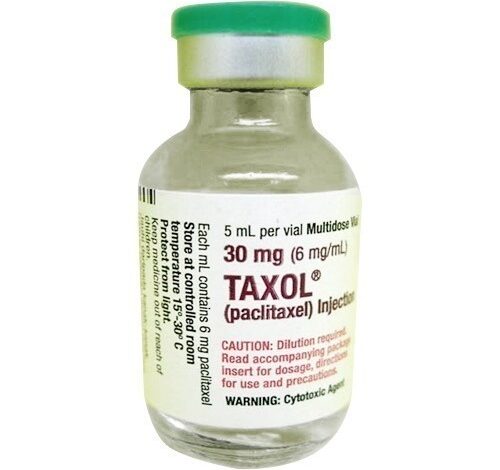Taxol: Uses, Dosage, Side Effects, How it works

Taxol is a brand of paclitaxel, a chemotherapy medication used to treat a number of types of cancer. This includes ovarian cancer, esophageal cancer, breast cancer, lung cancer, Kaposi’s sarcoma, cervical cancer, and pancreatic cancer. It is given by injection into a vein.
This medication is widely prescribed because it is effective for all stages of cancer. It’s among several medications in a class called taxanes, and it’s also used for other forms of cancer, such as ovarian cancer. Taxanes interfere with the ability of cancer cells to divide. Taxol usually is given in combination with other chemotherapy medicines and is used after surgery.
The FDA approved Taxol in December 1992, for the treatment of ovarian cancer. Researchers also tested the effectiveness of Taxol as a treatment for advanced breast cancer.
How Taxol Works
Tumor cells grow by a process called mitosis, the clinical name for cell division. Taxol is a mitotic inhibitor: It targets rapidly growing cancer cells by getting inside them and attaching to the scaffold-like structures of the cells called microtubules. In this way, the drug prevents cancer cells from dividing.
How is Taxol given?
Taxol is injected into a vein through an IV. A healthcare provider will give you this injection. You may be given other medications to prevent an allergic reaction while you are receiving Taxol.
Taxol is usually given once every 3 weeks. Follow your doctor’s dosing instructions very carefully.
Your breathing, blood pressure, oxygen levels, kidney function, and other vital signs will be watched closely while you are receiving this medicine.
Tell your caregivers if you feel any burning, pain, or swelling around the IV needle when Taxol is injected.
Taxol can lower blood cells that help your body fight infections and help your blood to clot. Your blood will need to be tested often. Your cancer treatments may be delayed based on the results of these tests.
What are the possible side effects of Taxol?
The following side effects have been reported by at least 1% of people taking Taxol. Many of these side effects can be managed, and some may go away on their own over time.
Contact your doctor if you experience these side effects and they are severe or bothersome. Your pharmacist may be able to advise you on managing side effects.
• abdominal pain
• changes in skin appearance
• diarrhea or loose, runny stools
• discolouration of the nail beds
• flushing
• dizziness when rising from a sitting or lying position
• numbness, burning, or tingling in the hands or feet
• pain in joints or muscles
• sores in the mouth and on the lips
• temporary loss of hair, eyebrows, eyelashes, and pubic hair about 2 to 3 weeks after treatment
• upset stomach (or nausea)
• vomiting
Although most of the side effects listed below don’t happen very often, they could lead to serious problems if you do not seek medical attention.
Check with your doctor as soon as possible if any of the following side effects occur:
• blurred vision or other visual changes
• cough or hoarseness with fever or chills
• fever or chills
• fast or irregular heartbeat, or lightheadedness occurring during your treatment
• pain or redness at the site of the injection
• severe weakness or tiredness
• signs of clotting problems (e.g., unusual nosebleeds, bruising, blood in urine, coughing blood, bleeding gums, cuts that don’t stop bleeding)
• signs of infection (symptoms may include fever or chills, severe diarrhea, shortness of breath, prolonged dizziness, headache, stiff neck, weight loss, or listlessness)
• signs of liver problems (e.g., nausea, vomiting, diarrhea, loss of appetite, weight loss, yellowing of the skin or whites of the eyes, dark urine, pale stools)
• shortness of breath or wheezing
• skin rash or itching or hives
• symptoms of a urinary tract infection (e.g. pain when urinating, urinating more often than usual, low back or flank pain)
Stop taking the medication and seek immediate medical attention if any of the following occur:
• chest pain
• seizures
• signs of a serious allergic reaction (e.g., abdominal cramps, difficulty breathing, nausea and vomiting, or swelling of the face and throat)
• signs of bleeding in the stomach (e.g., bloody, black, or tarry stools, spitting up of blood, vomiting blood or material that looks like coffee grounds)
• signs of a heart attack (e.g., chest pain or pressure, pain extending through shoulder and arm, nausea and vomiting, sweating)
• signs of a severe skin reaction such as blistering, peeling, a rash covering a large area of the body, a rash that spreads quickly, or a rash combined with fever or discomfort
Some people may experience side effects other than those listed. Check with your doctor if you notice any symptom that worries you while you are taking this medication.
Taxol Safety Information
Do not use Taxol without telling your doctor if you are pregnant. It could harm the unborn baby. Use effective birth control, and tell your doctor if you become pregnant during treatment.
Get emergency medical help if you have signs of an allergic reaction to Taxol: hives; difficult breathing; feeling like you might pass out; swelling of your face, lips, tongue, or throat.
Paclitaxel can lower blood cells that help your body fight infections and help your blood to clot. You may get an infection or bleed more easily. Call your doctor if you have unusual bruising or bleeding, or signs of infection (fever, chills, body aches).
Before you receive Taxol, tell your doctor if you have liver disease, heart disease, or a severely weak immune system.
Taxol can lower blood cells that help your body fight infections. This can make it easier for you to bleed from an injury or get sick from being around others who are ill. To be sure your blood cells do not get too low, your blood will need to be tested on a regular basis. Do not miss any scheduled appointments.
There are many other medicines that can interact with paclitaxel. Tell your doctor about all the prescription and over-the-counter medications you use. This includes vitamins, minerals, herbal products, and drugs prescribed by other doctors. Do not start using a new medication without telling your doctor. Keep a list with you of all the medicines you use and show this list to any doctor or other healthcare provider who treats you.





